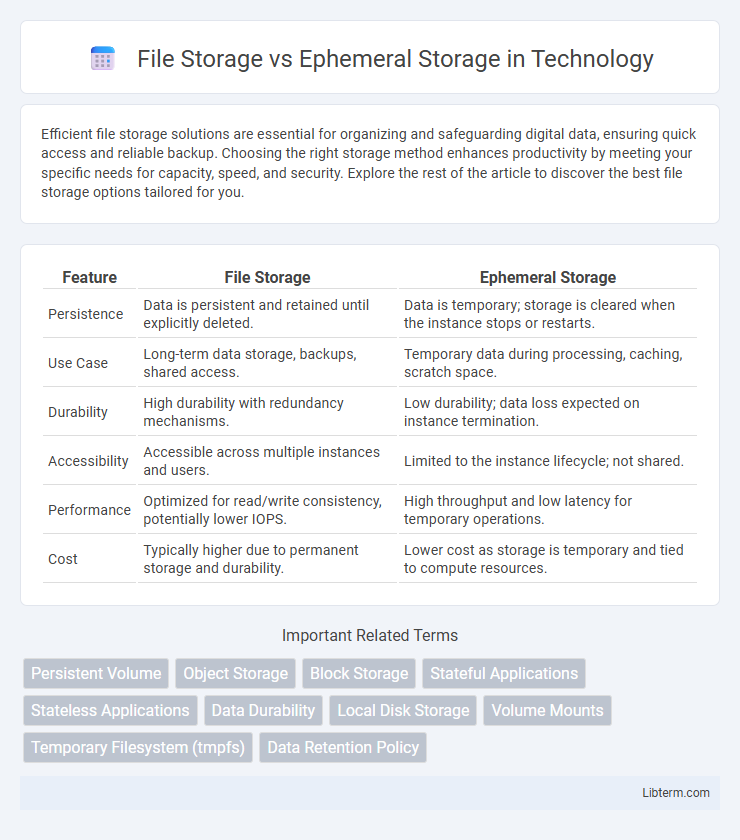Efficient file storage solutions are essential for organizing and safeguarding digital data, ensuring quick access and reliable backup. Choosing the right storage method enhances productivity by meeting your specific needs for capacity, speed, and security. Explore the rest of the article to discover the best file storage options tailored for you.
Table of Comparison
| Feature | File Storage | Ephemeral Storage |
|---|---|---|
| Persistence | Data is persistent and retained until explicitly deleted. | Data is temporary; storage is cleared when the instance stops or restarts. |
| Use Case | Long-term data storage, backups, shared access. | Temporary data during processing, caching, scratch space. |
| Durability | High durability with redundancy mechanisms. | Low durability; data loss expected on instance termination. |
| Accessibility | Accessible across multiple instances and users. | Limited to the instance lifecycle; not shared. |
| Performance | Optimized for read/write consistency, potentially lower IOPS. | High throughput and low latency for temporary operations. |
| Cost | Typically higher due to permanent storage and durability. | Lower cost as storage is temporary and tied to compute resources. |
Introduction to File Storage and Ephemeral Storage
File storage organizes data in a hierarchical structure, enabling persistent storage that supports file sharing and access across multiple devices. Ephemeral storage provides temporary storage that exists only during the lifespan of a session or instance, commonly used in cloud computing environments for short-term data caching or processing. Understanding the distinction between persistent file storage and transient ephemeral storage is critical for optimizing data management strategies in modern IT infrastructures.
Definition and Core Differences
File storage refers to a data storage architecture where information is saved in files within a hierarchical structure, enabling easy access, sharing, and management across multiple users and devices. Ephemeral storage, on the other hand, represents temporary storage typically associated with cloud computing instances, where data persists only during the lifecycle of a virtual machine and is lost upon termination or failure. The core difference lies in persistence: file storage provides durable, long-term data retention with consistent accessibility, while ephemeral storage offers short-lived, temporary data space optimized for transient computational tasks.
Use Cases for File Storage
File storage provides durable, persistent data storage ideal for applications requiring long-term data retention, such as document management systems, media libraries, and backup solutions. It supports file sharing and collaborative workflows, enabling multiple users to access and modify files simultaneously across networked environments. Enterprises leverage file storage for compliance, version control, and data archiving, ensuring consistent availability and reliability for critical business information.
Use Cases for Ephemeral Storage
Ephemeral storage is ideal for temporary data such as cache, session data, or intermediate processing files that do not require persistence beyond the lifecycle of a virtual machine or container. It supports high-performance computing tasks and real-time data processing where fast read/write speeds and low latency are critical. Use cases include stateless applications, big data analytics, and ephemeral workloads that benefit from storage automatically deleted upon instance termination.
Data Persistence and Durability Comparison
File storage ensures data persistence by saving files on durable hardware, making it suitable for long-term data retention and backups. Ephemeral storage provides temporary data storage tied to the lifecycle of a virtual machine or container, leading to data loss when the instance terminates or restarts. Comparing durability, file storage leverages redundant storage systems and regular backups to maintain data integrity, while ephemeral storage lacks inherent durability features, relying on external systems for data preservation.
Performance and Scalability Considerations
File storage offers consistent performance and high scalability by distributing data across multiple nodes, making it ideal for managing large datasets and enabling concurrent access with minimal latency. Ephemeral storage provides ultra-low latency and high I/O throughput for temporary data but lacks persistence, limiting its scalability and suitability for long-term storage. Balancing these factors, file storage supports sustained performance under heavy workloads, while ephemeral storage excels in transient, high-performance computing tasks where rapid data access is critical.
Security and Data Protection Aspects
File storage provides persistent, durable data retention with built-in encryption and access controls, ensuring robust protection against unauthorized access and data loss. Ephemeral storage, by contrast, offers temporary data retention tied to instance lifecycles and typically lacks built-in encryption, increasing risk exposure if proper security measures like data wiping and restricted access are not enforced. For sensitive workloads, file storage's comprehensive backup and compliance features deliver superior security and data integrity compared to ephemeral options.
Cost Implications of Storage Choices
File storage typically incurs higher costs due to persistent data retention and redundancy requirements, making it suitable for long-term data management. Ephemeral storage offers lower costs by providing temporary, non-persistent data storage ideal for short-term processing and transient workloads. Organizations must evaluate workload duration and durability needs to optimize expenses between durable file storage and cost-effective ephemeral storage solutions.
Best Practices for Choosing the Right Storage
Choosing between file storage and ephemeral storage depends on the need for data persistence and access patterns; file storage provides durable, shared access ideal for critical data and backups, while ephemeral storage offers temporary, high-speed access suited for transient data during application runtime. Best practices include using file storage for long-term retention, compliance, and collaboration scenarios, and ephemeral storage for caching, session data, or scratch space that is destroyed on instance termination. Evaluating workload requirements, data durability, and cost implications ensures optimal storage performance and reliability in cloud or on-prem environments.
Future Trends in Data Storage Solutions
File storage systems will increasingly integrate with cloud technologies, offering scalable and distributed access to large datasets, driven by advancements in object storage and edge computing. Ephemeral storage solutions will evolve to support faster data processing and real-time analytics, leveraging innovations in non-volatile memory and serverless architectures. Emerging trends emphasize hybrid models combining persistent file storage with ephemeral layers to balance durability, speed, and cost-efficiency in next-generation data infrastructure.
File Storage Infographic

 libterm.com
libterm.com